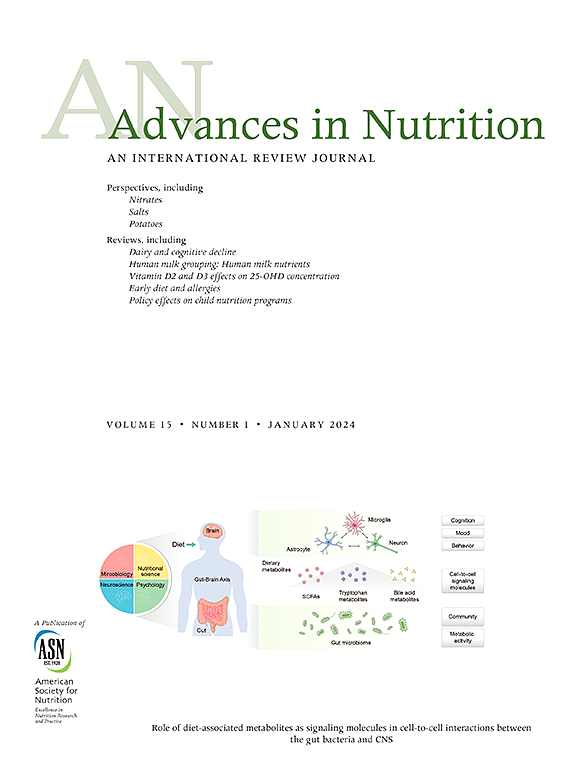观点:异黄酮——令人着迷的分子,但对这些大豆成分仍有许多有待了解。
IF 9.2
1区 医学
Q1 NUTRITION & DIETETICS
引用次数: 0
摘要
异黄酮是一种天然存在的化合物,存在于多种植物中,但在常见的食用食物中,大豆及其衍生食品中的异黄酮含量尤其丰富。在过去的30年里对大豆蛋白和大豆食品进行的大量研究都是因为它们的异黄酮含量。从20世纪90年代初开始,异黄酮的研究兴趣急剧增加,因为有证据表明它们可能在预防多种癌症方面发挥作用,包括乳腺癌、前列腺癌和结肠癌。与雌激素受体α相比,异黄酮更倾向于与雌激素受体β结合,这为将这些二酚类分子分类为选择性雌激素受体调节剂提供了概念基础。异黄酮的研究很快就从癌症扩展到冠状动脉疾病、骨骼健康、认知功能和更年期血管舒缩症状等领域。然而,主要基于动物研究结果和假定的雌激素效应的异黄酮的安全问题也出现了。然而,最近的工作挑战了异黄酮具有雌激素性的传统观点。此外,干预和人口研究在很大程度上驳斥了安全问题。另一方面,对异黄酮益处的调查得出了不一致的数据。许多干预试验常见的小样本量和短时间,加上异黄酮代谢的显着个体间差异,可能导致相互矛盾的发现。此外,采用了许多不同的干预产品,这些产品不仅在总量上不同,而且在三种大豆异黄酮的相对比例上也不同,以及它们的递送形式(糖苷与苷元)也不同。对于那些对探索异黄酮的益处感兴趣的人,研究证明摄入量建议为~ 50毫克/天,大约两份传统亚洲大豆食品提供的量。本文章由计算机程序翻译,如有差异,请以英文原文为准。
Perspective: Isoflavones—Intriguing Molecules but Much Remains to Be Learned about These Soybean Constituents
Isoflavones are naturally occurring compounds found in a wide range of plants, but among commonly consumed foods are especially abundant in soybeans and foods derived from this legume. Much of the substantial amount of research conducted on soy protein and soy foods over the past 30 y is because of their isoflavone content. Research interest in isoflavones increased dramatically beginning in the early 1990s as evidence highlighted their possible role in the prevention of a wide range of cancers, including breast, prostate, and colon cancer. Recognition that isoflavones preferentially bind to estrogen receptor (ER)β in comparison with ERα provided a conceptual basis for classifying these diphenolic molecules as selective ER modulators (SERMs). Isoflavone research soon greatly expanded beyond cancer to include areas such as coronary artery disease, bone health, cognitive function, and vasomotor symptoms of menopause. Nevertheless, safety concerns about isoflavones, based primarily on the results of rodent studies and presumed estrogenic effects, also arose. However, recent work challenges the traditional view of the estrogenicity of isoflavones. Furthermore, safety concerns have largely been refuted by intervention and population studies. On the other hand, investigation of the proposed benefits of isoflavones has produced inconsistent data. The small sample size and short duration common to many intervention trials, combined with marked interindividual differences in isoflavone metabolism, likely contribute to the conflicting findings. Also, many different intervention products have been employed, which vary not only in the total amount, but also in the relative proportion of the 3 soybean isoflavones, and the form in which they are delivered (glycoside compared with aglycone). For those interested in exploring the proposed benefits of isoflavones, studies justify an intake recommendation of ∼50 mg/d, an amount provided by ∼2 servings of traditional Asian soy foods.
求助全文
通过发布文献求助,成功后即可免费获取论文全文。
去求助
来源期刊

Advances in Nutrition
医学-营养学
CiteScore
17.40
自引率
2.20%
发文量
117
审稿时长
56 days
期刊介绍:
Advances in Nutrition (AN/Adv Nutr) publishes focused reviews on pivotal findings and recent research across all domains relevant to nutritional scientists and biomedical researchers. This encompasses nutrition-related research spanning biochemical, molecular, and genetic studies using experimental animal models, domestic animals, and human subjects. The journal also emphasizes clinical nutrition, epidemiology and public health, and nutrition education. Review articles concentrate on recent progress rather than broad historical developments.
In addition to review articles, AN includes Perspectives, Letters to the Editor, and supplements. Supplement proposals require pre-approval by the editor before submission. The journal features reports and position papers from the American Society for Nutrition, summaries of major government and foundation reports, and Nutrient Information briefs providing crucial details about dietary requirements, food sources, deficiencies, and other essential nutrient information. All submissions with scientific content undergo peer review by the Editors or their designees prior to acceptance for publication.
 求助内容:
求助内容: 应助结果提醒方式:
应助结果提醒方式:


